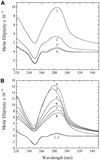Unique condensation patterns of triplex DNA: physical aspects and physiological implications
- PMID: 12000835
- PMCID: PMC115281
- DOI: 10.1093/nar/30.10.2154
Unique condensation patterns of triplex DNA: physical aspects and physiological implications
Abstract
Triple-stranded DNA structures can be formed in living cells, either by native DNA sequences or following the application of antigene strategies, in which triplex-forming oligonucleotides are targeted to the nucleus. Recent studies imply that triplex motifs may play a role in DNA transcription, recombination and condensation processes in vivo. Here we show that very short triple-stranded DNA motifs, but not double-stranded segments of a comparable length, self-assemble into highly condensed and ordered structures. The condensation process, studied by circular dichroism and polarized-light microscopy, occurs under conditions that mimic cellular environments in terms of ionic strength, ionic composition and crowding. We argue that the unique tendency of triplex DNA structures to self-assemble, a priori unexpected in light of the very short length and the large charge density of these motifs, reflects the presence of strong attractive interactions that result from enhanced ion correlations. The results provide, as such, a direct experimental link between charge density, attractive interactions between like-charge polymers and DNA packaging. Moreover, the observations strongly support the notion that triple-stranded DNA motifs may be involved in the regulation of chromosome organization in living cells.
Figures





References
-
- Jaworski A., Hsieh,W.T., Blaho,J.A., Larson,J.E. and Wells,R.D. (1987) Left-handed DNA in vivo. Science, 238, 773–777. - PubMed
-
- Wells R.D. (1988) Unusual DNA structures. J. Biol. Chem., 263, 1095–1098. - PubMed
-
- Palecek E. (1991) Local supercoil-stabilized DNA structures. Crit. Rev. Biochem. Mol. Biol., 26, 151–226. - PubMed
-
- van Holde K. and Zlatanova,J. (1994) Unusual DNA structures, chromatin and transcription. Bioessays, 16, 59–68. - PubMed
-
- Burkholder G.D., Latimer,L.J.P. and Lee,J.S. (1991) Immunofluorescent localization of triplex DNA in polytene chromosomes of Chironomus and Drosophila. Chromosoma, 101, 11–18. - PubMed

